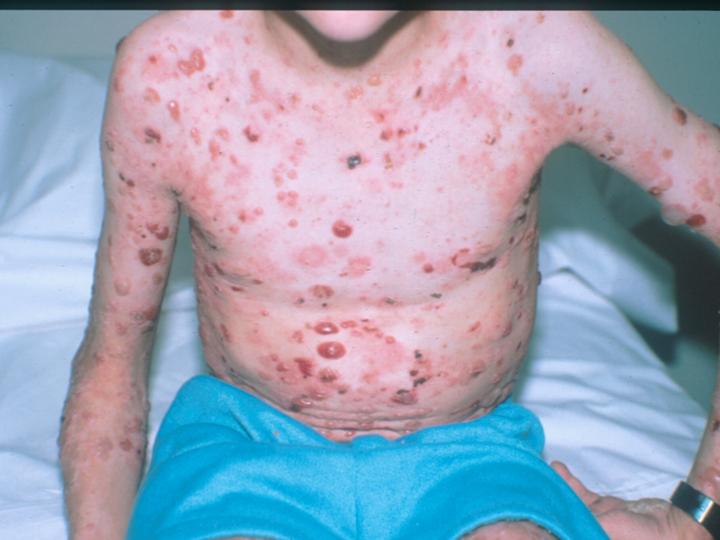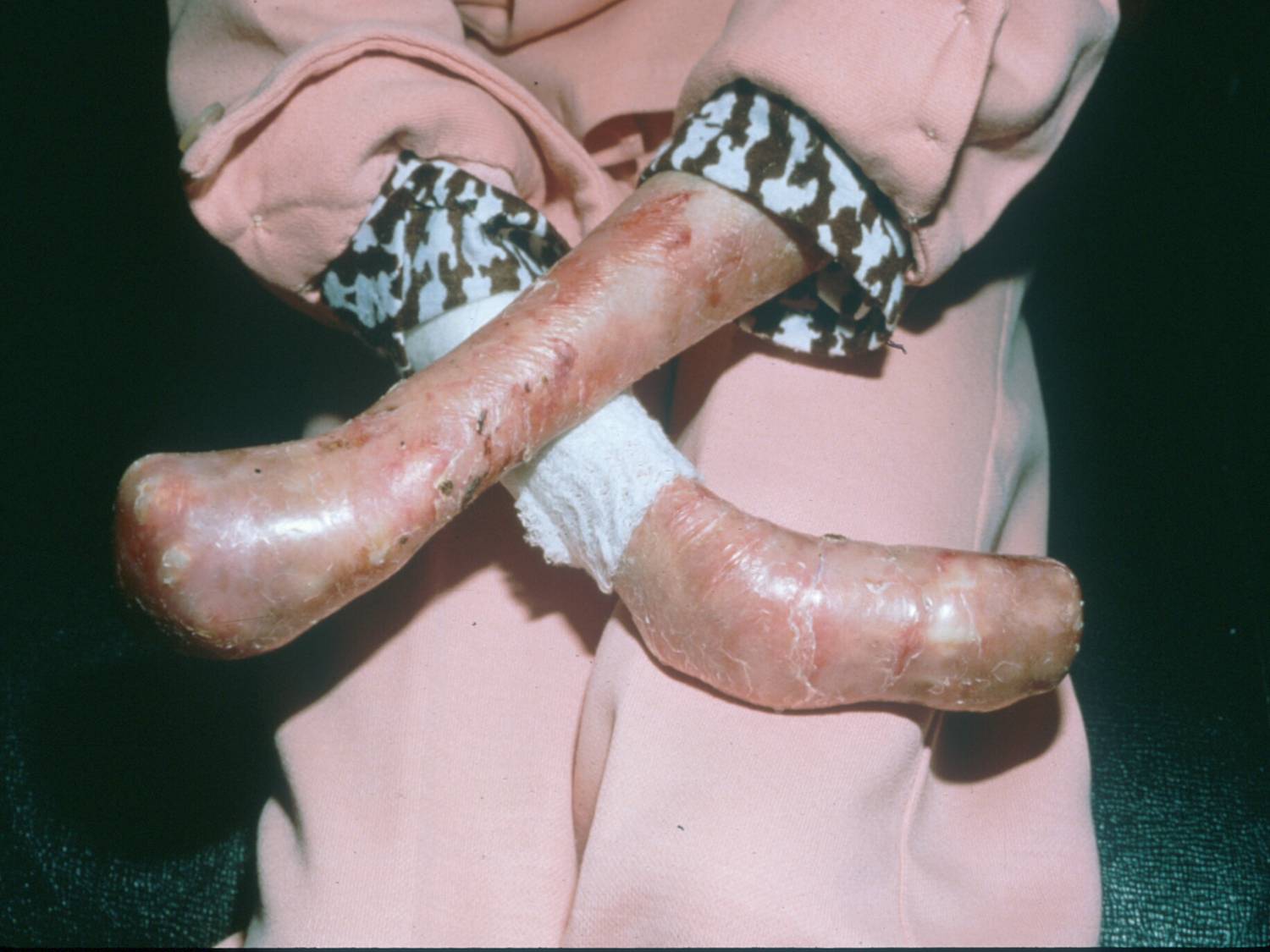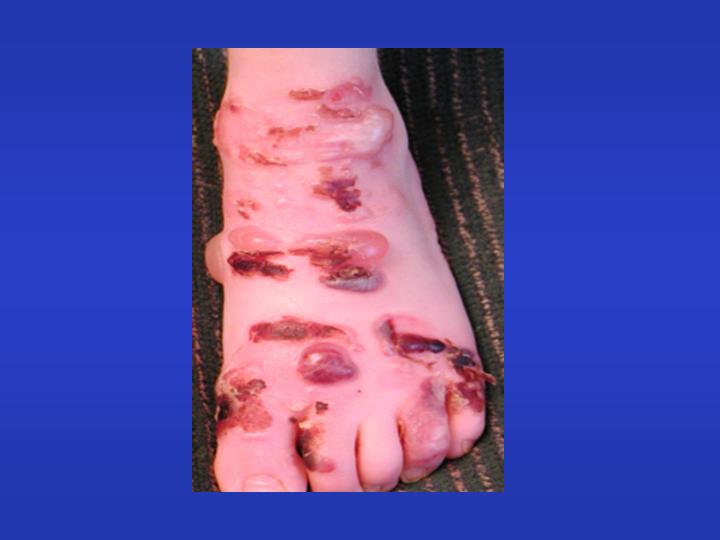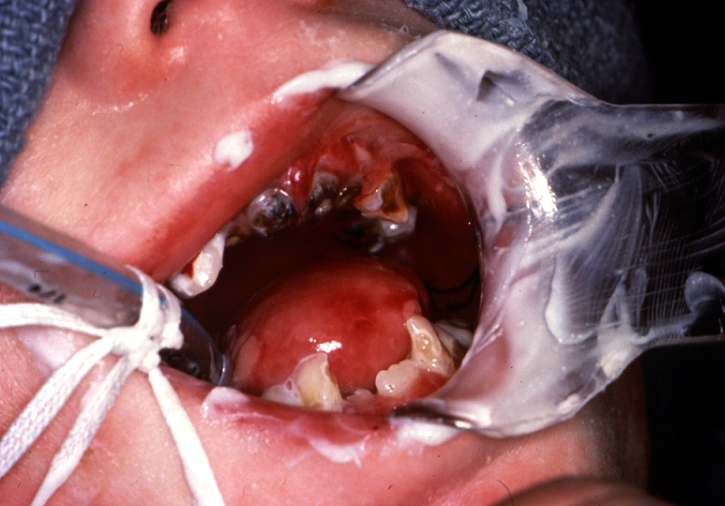This Page Is Intended For The Medical Professional
Definition
Epidermolysis Bullosa (EB) encompasses a group of otherwise heterogeneous diseases characterized by the development of blisters after a minor trauma to the skin. Most cases are inherited; rare cases are acquired. The inherited form of EB has 3 major subtypes- EB Simplex (EBS), Junctional EB (JEB), and dystrophic EB (DEB)- based on whether blisters arise in the epidermis or in the middle, lamina lucida, or the undersurface of the lowermost portion, lamina densa, of the dermoepidermal junction. Individual subtypes of inherited EB are further defined by their mode of inheritance, ultrastructure site of skin cleavage, appearance and number of specific structures in keratinocytes and the adjacent dermoepidermal junction. Also the presence or absence of specific cutaneous and extracutaneous manifestations. A noninherited form of EB, EB aquista, is caused from an autoimmunity to type VII collagen, the major structural component of the anchoring fibril.
Inherited forms EB Subtypes
EB Simplex
Localized EBS
EBS of hands and feet (Weber-Cockayne )
EBS with anodontia/hypodontia (Kallin Syndrome)
Generalized EBS
EBS Koebner
EBS herpetiformis ( Dowling-Meara)
EBS with mottled pigmentation with or without keratoderma
EBS superficialis
EBS ogna
Autosomal recessive EBS Letalis With or without associated neuromuscular disease
EBS Mendes da Costa
Junctional EB
Localized JEB
JEB inversa
JEB acral minimus
JEB progressiva Neurophica
Generalized JEB
JEB gravis ( Herlitz)
JEB mitis ( non-Herlitz )
JEB Cicatrical
JEB Pyloria atresia
Dystrophic EB
Localized DEB
RDEB inversa
DEB acral minimus
DDEB pretibial
RDEB centripetalis
DEB Pruiginosa
Generalized DEB
DEB Autosomal dominate forms
DDEB albopapuloidea (Pasini)
DDEB hyperplasique (Cockayne-Touraine)
Transient Bullous dermolysis of the newborn
DEB Autosomal recessive forms
RDEB gravis ( Hallopeau-Siemens )
RDEB mitis
Transient bullous dermolysis of the newborn
Subtypes of EB Simplex
Localized EBS
The most common form of localized EBS in Weber-Cockayne, or EB of the hands and feet. It is Autosomal dominant, presents during infancy or early childhood. Affects the palms and soles with blisters erosions and crusts. Erosions in the mouth are not uncommon during early childhood and usually disappear with increasing age. A rare form of localized EBS Kallin syndrome. It is Autosomal recessive, onset during infancy. Thickened curved nails are characteristic of this subtype, along with childhood alopecia.
Generalized EBS
There are 2 major forms of generalized EBS. The first is Koebner. It is Autosomal dominate, presents during infancy and early childhood, inspite of being a generalized form the extremities are more severely involved, than the face and trunk. Milia, scaring, and nail dystrophy may be seen. The second subtype is Dowling-Meara. It is Autosomal dominate, this severe subtype is seen at birth, with milia, and atrophic scarring, and nail dystrophy are more common in this subtype than others. The hallmark sign is the herpetiform grouping of vesicles or blisters. Oral cavity erosions may be extensive and natal teeth are rare. Another rare but severe form is EB Letalis. It is Autosomal recessive with neuromuscular disease, present at birth, characterized by generalized blistering. Nail dystrophy, milia atrophic scarring and scarring alopecia are seen. Limb girdle muscular dystrophy is usually associated, and infantile or childhood mortality is common.
Junctional EB (JEB)
Localized JEB
A rare form of JEB is Minimus JEB, like all JEB, is Autosomal recessive, present at birth with hands, feet, and pretibial regions of the legs. Intraoral erosions are common. Another rare form of JEB is EB Progressiva, onset late childhood. Skin involvement is on the hands, feet, elbows, and knees. Nails are either absent or dystrophic, intraoral erosions are present. Another rare form of JEB is Inversa. Present at birth, areas involved are in inverse areas, i.e. Skin folds, axillary vaults and groin. Atrophic scarring, dystrophic or absent nails, intraoral erosions are common. The esophagus and anus can be severely involved.
Generalized JEB
The most severe subtype of generalized JEB is Herlitz or Gravis. The hallmark sign is cutaneous atrophy without scarring, present at birth, nails are absent, milia may appear on the scalp and cause alopecia. The most striking cutaneous finding is the presence of exuberant granulation tissue, when extensive it may appear vegetative. Extensive intraoral erosions are common, with scarring, microstomia and ankyloglossia. Enamel hypoplasia is present and excessive carries, Severe multifactorial anemia and growth retardation occur. The major concern in all subtypes of JEB is recurrent blistering and strictures of the tracheolaryngeal area, which may lead to sudden airway occlusion and death. Infant mortality is very high, secondary to sepsis, tracheolarygneal occlusion, and progressive failure to thrive.
Dystrophic EB (DEB)
Localized DEB
One form of DEB is Minimus Dominant DEB (DDEB), present at birth or early childhood, tends to involve acral areas, blisters grow more mild and may even disappear as age increases, nails tend to be dystrophic. A second form is Pretibial DDEB, onset early childhood, pretibial skin and dorsal feet are involved. Nails tend to be abnormal.
Generalized DEB
One form of DEB is Pasini, onset at birth, associated with the absence of nails, atrophic scarring, and milia. Intraoral erosions are common, and anemia is absent. The most severe subtype of DEB is Hallopeau-Siemens, it is Autosomal recessive. Present at birth, develop milia, have absent of dystrophic nails, and extensive atrophic scarring. Oral cavity is severely involved, with erosions, blisters, soft tissue scarring, microstomia, ankloglossia, and carries. Mulitfractorial anemia, and grow retardation are profound. A characteristic feature of RDEB is progressive acral contractures and partial or complete mitten deformities of hands and feet. The esophagus intestine and anus can be severely affected, as well as the urethra, bladder and vagina. Patients with RDEB-HS are at risk of dying from sepsis, and are also at high risk for developing Squamous cell carcinoma in young to middle childhood.
References
Fine JD, Bauer E, McGuire J, Moshell A, Epidermolysis Bullosa clinical, epidermiologic, and laboratory advances and the findings of the national Epidermolysis Bullosa registry, John Hopkins University Press,1999 1-37.

































